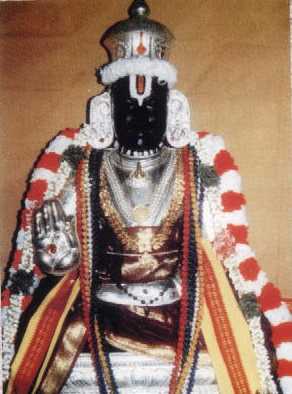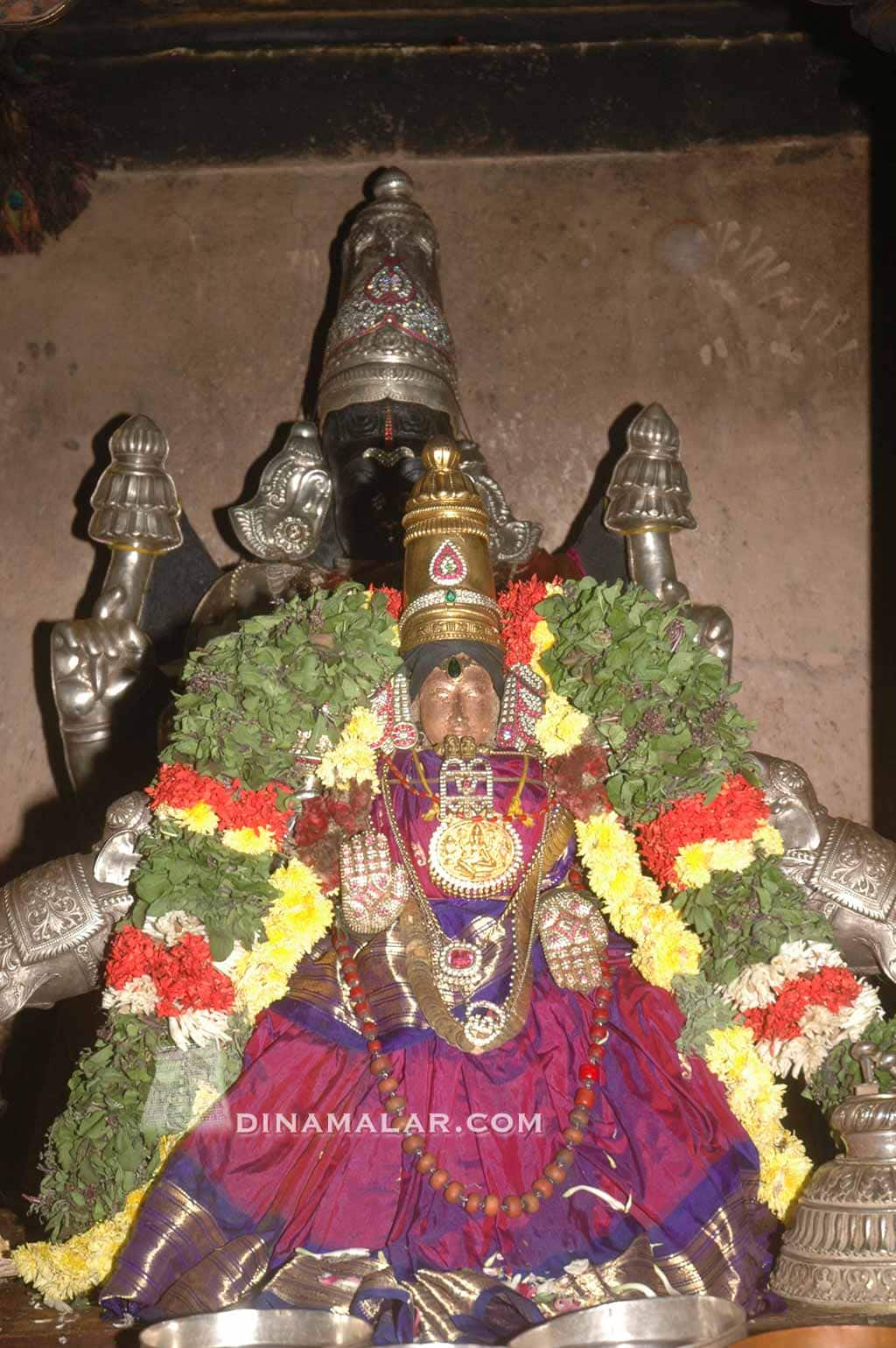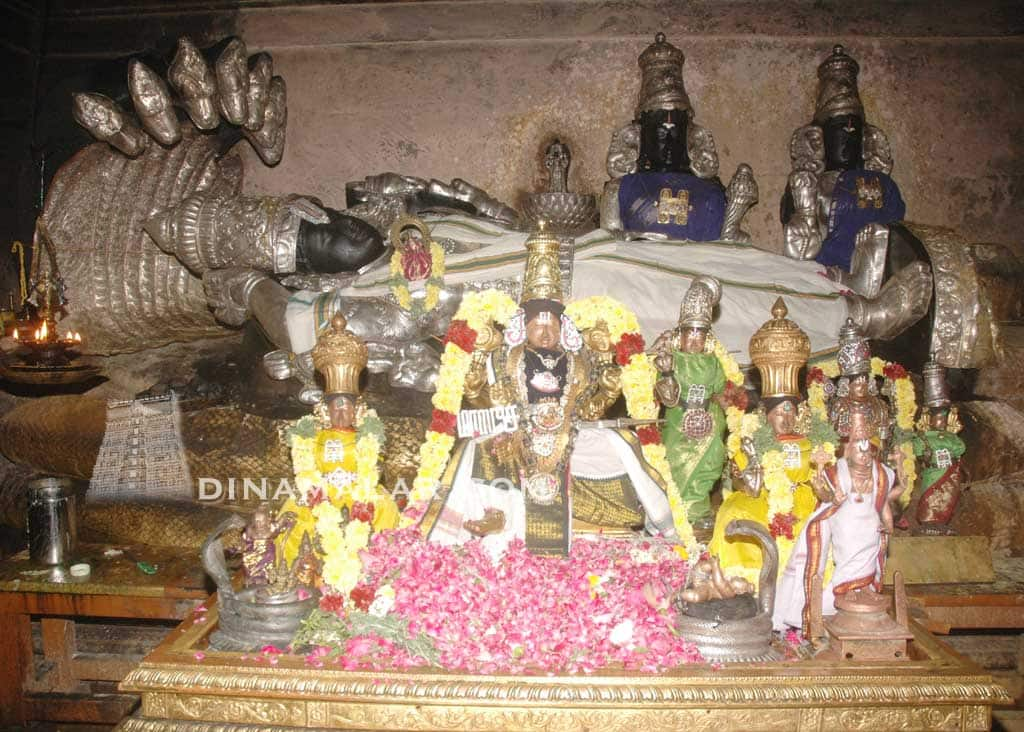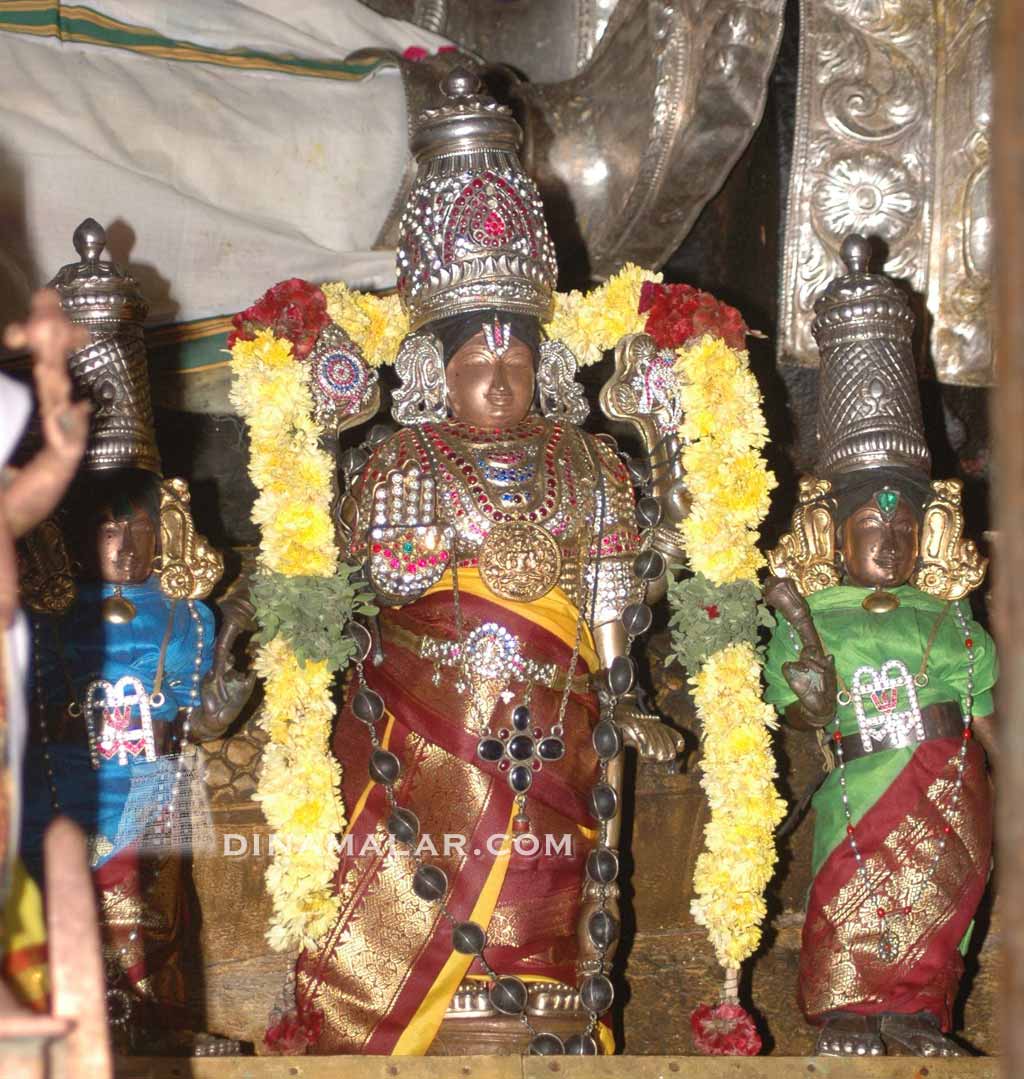yath padhAmbhOruhadhyAna vidhvasthAsEsha kalmasha:
vasthuthAmupayA dhOham yAmunEyam namAmitham
vasthuthAmupayA dhOham yAmunEyam namAmitham
This sloka in praise of Swami Alavandar (ஆளவந்தார்) was composed by Swami Ramanuja. Like his grandfather Swami Nathamuni, Swami Alavandar also was born in this kshetram, Kattu Mannar Koil. Iswara Muni was the son of Swami Natahamuni and Swami Alavandar, whose original name was Yamunai Thuraivan (யமுனைத்துறைவன்) was the son of Iswara Muni. We will now see briefly, how Yamunai Thuraivan became Swami Alavandar and how he became the Acharya of Swami Ramanuja.
There was a King in the region where Yamunai Thuraivan lived when he was a boy. Tha King had a vidwan (pundit) Akki Alwan (ஆக்கி ஆள்வான்) and the King was very proud that none could defeat his vidwan in learning. But the King was also aware that Yamunai Thuraivan was also well learned and so he wanted to engage him in a debate with his vidwan Akki Alwan. So a letter was sent to Yamunai Thuraivan to come to the Royal Assembly. But Yamunai Thuraivan rejected it and a fierce argument took place between the King and his Queen, who supported Yamunai Thuraivan. It was decided between them that in case Yamunai Thuraivan won a debate with Akki Alwan, the King would grant him half his Kingdom. Accordingly, a palanquin was sent to invite Yamunai Thuraivan.
When Yamunai Thuraivan arrived, the Vidwan mocked at him and asked him whether he had studied anything? Yamunai Thuraivan replied that setting aside what he learnt, he wanted Akki Alwan should refute some simple statements Yamunai Thuraivan would make and establish his refutals with proper supporting Shastras. Yamunai Thuraivan put forward Three statements. First was that Akki Alawan's mother was not infertile. Akki Alwan should refute this by stating that his mother was infertile and had no children! The Second statement was that the King was righteous and Akki Alwan should refute this by saying that the King was not righteous! Finally, the Third statement was even more disastrous! Yamunai Thuraivan stated that the Queen was a chaste woman and Akki Alwan should refute it by stating that the Queen was not chaste! Akki Alwan was terribly embarrassed as each statement was potent with serious consequences. So, Akki Alwan demanded answers from Yamunai Thuraivan, failing which he would be subject to serious punishments by the King!
Yamunai Thuraivan accepted and gave fitting replies. For the First statement, according to Shastras, the banana tree which gives only one yield is considered infertile and so any woman who had only one child is supposed to be infertile! And, Akki Alwan was his mother's only child!
As per Shastras, though a King may be righteous, any misdoings by his subjects are considered as the King's misdoings and so that way the King is not righteous!
Since the Queen differed with the King regarding the supremacy of Akki Alwan, as per Shastras, she was not 100% chaste!
Thus Akki Alwan was defeated and the Queen was very much pleased and conferred the title "nammai alavandeer!" (நம்மை ஆளவந்தீர்! you have come to rule us!), indicating her triumph over the King! Thus Yamunai Thuraivan became Alavandar ("Come to Rule" )! Yamunai Thuraivan also got half the Kingdom and became a King! But how can a King become an Acharya?!
Swami Nathamuni had a disciple Uyyak Kondar (உய்யக்கொண்டார்). His disciple was Manakkal Nambi(மணக்கால் நம்பி) and Yamunai Thuraivar became his disciple. Swami Nathamuni had left lots of learning to be imparted to his grandson and had accordingly instructed his disciple Uyyak Kondar. He could not do that and this responsibility was passed on to Manakkal Nambi, who could not get the audience of King Yamunai Thuraivan! He devised a plan and supplied 'tuduvalai' greens (தூதுவளை கீரை) to the royal cook to properly cook and serve in the daily meals for the King Yamunai Thuraivan. The cook did that and this went on for nearly six months. Then Manakkal Nambi suddenly stopped the supply. The King noticed the change and wanted to meet the person who was supplying the greens. When Manakkal Nambi appeared again, the cook promptly took him to the King Yamunai Thuraivan! The King asked Manakkal Nambi as what was he expecting in supplying greens to the King. Manakkal Nambi replied that he did not want anything but wanted to give the King the 'wealth' his grandfather had deposited with Nambi. Then Nambi told that the great 'wealth' of Bagawat Gita was to be passed on to Yamunai Thuraivan. Then he preached Gita to Yamunai Thuraivan and he learnt it with great enthusiasm. Then, he wanted Nambi to show him the Lord mentioned in Gita and Nambi took him to Srirangam and got him a darshan of Lord Sri Ranganatha. The Lord also graced Alavandar specially and immediately, Alavandar renounced his kingdom and family and took to Sanyasam or priesthood. His disciple was Swami Periya Nambi, whose disciple was Swami Ramanuja. Swami Ramanuja was not the direct disciple of Swami Alavandar. Like Ekalavya to Drona, Swami Ramnuja was not a direct disciple of Swami Alavandar.
In his lifetime, Swami Alavandar once on a visit to Kanchipuram, saw Ilaiyazhwar (இளையாழவார் original name of Swami Ramanuja) at the Kariya Manikka Perumal sannidhi ( கரிய மாணிக்க பெருமாள்) along with Ilaiazhwar's at that time Acharya Swami Yadava Prakasa. Swami Alavandar blessed him from a distance. That is why Swami Ramanuja pays his tribute (as mentioned in the beginning of this post) that he bows to Swami Yamunacharya, because of whom he, with all blemishes, became a worthy person. But for Swami Alavandar, Swami Ramanuja would not have been able to write Gita Bhashyam and we would not be knowing Gita as being described in these posts. Swami Alavandar composed Siddhitrayam, Stotra Ratnam and Chatusloki.
We will briefly see today's sloka, 35:
Again another four groups are mentioned. Of samams, He is brihatsamam. Sama Veda is musical portion of the Vedas. There are Two Samams: Brihat Samam and Rasansara Samam. Brihat Samam represents the mind and Rasansara Samam represents the speech. Then He says that He is Gayatri among chandas (poetic metres). Gayatri chandas is one of the Seven chandas, which, as horses, pull the chariot of the Sun. Gayatri chandas has 24 syllables, in one sloka. It is considered as the Mother of chandas. The Lord says that He is the month Margaseersha (Tamil Margazhi corresponding to December-January) among months. That is the month when people get up very early and chant Tiruppavai and worship the Lord in temples. This month is the early morning for Devas. Our one Earth year is equal to one day for Devas. Then Lord Sri Krishna says that He is Vasanta Rutu among Six Rutus. That is He is the Spring season in a year. That is the season when flowers blossom. We will now take leave of Kattu Mannar Koil.
(continued)
Yamunai Thuraivan accepted and gave fitting replies. For the First statement, according to Shastras, the banana tree which gives only one yield is considered infertile and so any woman who had only one child is supposed to be infertile! And, Akki Alwan was his mother's only child!
As per Shastras, though a King may be righteous, any misdoings by his subjects are considered as the King's misdoings and so that way the King is not righteous!
Since the Queen differed with the King regarding the supremacy of Akki Alwan, as per Shastras, she was not 100% chaste!
Thus Akki Alwan was defeated and the Queen was very much pleased and conferred the title "nammai alavandeer!" (நம்மை ஆளவந்தீர்! you have come to rule us!), indicating her triumph over the King! Thus Yamunai Thuraivan became Alavandar ("Come to Rule" )! Yamunai Thuraivan also got half the Kingdom and became a King! But how can a King become an Acharya?!
Swami Nathamuni had a disciple Uyyak Kondar (உய்யக்கொண்டார்). His disciple was Manakkal Nambi(மணக்கால் நம்பி) and Yamunai Thuraivar became his disciple. Swami Nathamuni had left lots of learning to be imparted to his grandson and had accordingly instructed his disciple Uyyak Kondar. He could not do that and this responsibility was passed on to Manakkal Nambi, who could not get the audience of King Yamunai Thuraivan! He devised a plan and supplied 'tuduvalai' greens (தூதுவளை கீரை) to the royal cook to properly cook and serve in the daily meals for the King Yamunai Thuraivan. The cook did that and this went on for nearly six months. Then Manakkal Nambi suddenly stopped the supply. The King noticed the change and wanted to meet the person who was supplying the greens. When Manakkal Nambi appeared again, the cook promptly took him to the King Yamunai Thuraivan! The King asked Manakkal Nambi as what was he expecting in supplying greens to the King. Manakkal Nambi replied that he did not want anything but wanted to give the King the 'wealth' his grandfather had deposited with Nambi. Then Nambi told that the great 'wealth' of Bagawat Gita was to be passed on to Yamunai Thuraivan. Then he preached Gita to Yamunai Thuraivan and he learnt it with great enthusiasm. Then, he wanted Nambi to show him the Lord mentioned in Gita and Nambi took him to Srirangam and got him a darshan of Lord Sri Ranganatha. The Lord also graced Alavandar specially and immediately, Alavandar renounced his kingdom and family and took to Sanyasam or priesthood. His disciple was Swami Periya Nambi, whose disciple was Swami Ramanuja. Swami Ramanuja was not the direct disciple of Swami Alavandar. Like Ekalavya to Drona, Swami Ramnuja was not a direct disciple of Swami Alavandar.
In his lifetime, Swami Alavandar once on a visit to Kanchipuram, saw Ilaiyazhwar (இளையாழவார் original name of Swami Ramanuja) at the Kariya Manikka Perumal sannidhi ( கரிய மாணிக்க பெருமாள்) along with Ilaiazhwar's at that time Acharya Swami Yadava Prakasa. Swami Alavandar blessed him from a distance. That is why Swami Ramanuja pays his tribute (as mentioned in the beginning of this post) that he bows to Swami Yamunacharya, because of whom he, with all blemishes, became a worthy person. But for Swami Alavandar, Swami Ramanuja would not have been able to write Gita Bhashyam and we would not be knowing Gita as being described in these posts. Swami Alavandar composed Siddhitrayam, Stotra Ratnam and Chatusloki.
 |
| SWAMI ALAVANDAR |
We will briefly see today's sloka, 35:
brhat-sama tatha samnam
gayatri chandasam aham
masanam marga-sirso 'ham
rtunam kusumakarah
gayatri chandasam aham
masanam marga-sirso 'ham
rtunam kusumakarah
"Of hymns, I am the Brhat-sama sung to the Lord Indra, and of poetry, I am the Gayatri verse, sung daily by Brahmanas. Of months, I am November and December, and of seasons, I am flower-bearing spring."
 |
| SWAMI NATHAMUNI AND GRANDSON SWAMI ALAVANDAR |
(continued)










